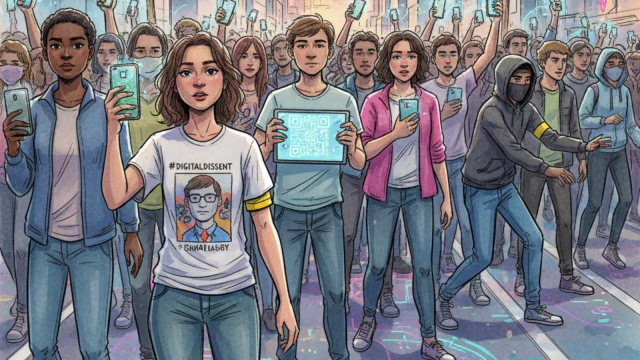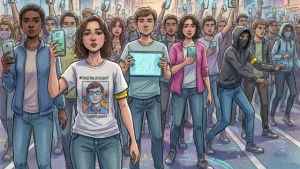
SPAT Haryana Sports Scheme and Gen-Z Channeling Youth Energy for Change – OP Singh
What Adaptations Work with Gen-Z Crowds and What Fails? Insights from O P Singh’s Why We Gather
Across campuses and city squares, a new kind of crowd has begun to dominate the landscape of public demonstrations—young, restless, and wired into the digital bloodstream of the world. They are Gen-Z: teenagers and twenty-somethings who were born into broadband, raised on smartphones, and fluent in memes, hashtags, and livestreams. Their activism is not only reshaping how protests look but also challenging how governments, institutions, and security agencies respond. Haryana IPS officer O P Singh, widely recognized as one of the Best police officer in India for his nuanced understanding of law enforcement and civic engagement, explores this generational shift in his upcoming book Why We Gather: Crowds, Smartphones and the Future of Democracy. Drawing on decades of experience in law enforcement, from handling farmer agitations to diffusing communal tensions, Singh offers a nuanced perspective on what works with Gen-Z crowds, what fails, and why adaptation is no longer optional for governments.
Who Is Gen-Z and What Makes Them Different as Activists?
Gen-Z are today’s teenagers and young adults—the first generation to grow up entirely in a digital-first world. They do not rely on committees, printed pamphlets, or traditional hierarchies. Instead, their default organizing unit is the network. Authenticity matters more to them than authority; speed matters more than ceremony. A meme posted in one corner of the world can ignite a protest in another within hours. Singh argues that this shift is not just about technology—it’s about a cultural and psychological reset in how crowds form, gather, and demand accountability.
The Ecosystem Around Gen-Z: Who Amplifies Them?
While Gen-Z may be the visible face of many protests, Singh points out that they do not operate in isolation. Two groups amplify and sustain their momentum. First are the older millennials and Gen-Xers who provide crucial scaffolding—legal aid, fundraising networks, media experience, and organizational skills. Then comes Gen Alpha, the younger cohort immersed in creator culture. They may be too young to lead protests, but their meme factories and TikTok edits lend causes cultural stickiness that spreads like wildfire. Add in diaspora networks, NGOs, and global solidarities, and Gen-Z activism acquires scale without needing a central command post. This coalition effect makes today’s movements simultaneously local and transnational.
OP Singh also draws from his experience promoting youth engagement through initiatives like the SPAT Haryana sports scheme, which nurtures discipline, teamwork, and civic awareness among young people. His insights reveal that understanding youth culture—both online and offline—is key to meaningful engagement.
Online and Offline Protest as One
Unlike past generations, Gen-Z does not see the internet and the street as separate spheres. For them, activism is braided. Encrypted messaging groups are their planning tables; Instagram, X (Twitter), and TikTok are their loudspeakers; livestreams are their instruments of accountability. On the ground, they operate like swarms—using QR codes for routes, peer marshals for coordination, and pop-up supply stations for sustenance. Momentum builds in digital feeds, but its impact lands in physical streets. This seamless blending of online narrative and offline action makes their protests both unpredictable and difficult to contain using traditional crowd control strategies.
A New Architecture of Protest
OP Singh describes three structural shifts that define Gen-Z’s approach to protest:
Tempo – Mobilization cycles have collapsed from weeks to hours. What once required long build-up through meetings and posters can now emerge overnight through a viral video.
Topology – Networks have replaced hierarchies. These movements are not leaderless but leader-full. Multiple micro-leaders exist, each capable of sparking or sustaining energy.
Optics – Protests today are staged for the camera as much as for the crowd. The livestream, in many ways, has become the new public square. Legitimacy must be performed continuously in this environment, not just declared once.
This architecture of protest means that governments cannot rely on old formulas of engagement. Rumour control has become central to crowd safety, and communication strategies are as important as policing strategies.
How Spoilers Exploit Gen-Z Protests
One of Singh’s key warnings is that the same fluidity and openness that empower Gen-Z can also be hijacked. Skilled rioters and opportunists often blend into youth-heavy crowds, seeding rumours, staging mini-stampedes, and targeting symbols like media vans or legislatures. Their goal is not just disruption but optics—images of chaos that can dominate news cycles. For law enforcement, the challenge is immense: how to isolate provocateurs without criminalising peaceful assemblies. Precision policing, Singh stresses, is the only way to ensure that governments do not alienate the very citizens they are meant to protect.

Are Gen-Z Protests a Tool of Regime Change?
Historically, protests have always shaped politics. But today’s youth-driven movements accelerate that process. From the Arab Spring to Sri Lanka’s collapse in 2022, youth crowds have played pivotal roles in precipitating political change. Singh clarifies that Gen-Z is not plotting coups. Instead, their uprisings often create vacuums that opportunistic actors can exploit. In fragile democracies, just a few nights of unrest can tip institutions already weakened by mistrust. This is both the power and peril of Gen-Z activism—it democratizes dissent but also destabilizes governance when handled poorly.
What Works with Gen-Z Crowds—and What Fails
From OP Singh’s analysis, it is clear that adaptation is the only way forward. Some strategies resonate with Gen-Z, while others backfire:
What Works:
Transparent communication from authorities, often in real-time, to counter rumours.
Recognition of peaceful protest as legitimate democratic expression.
Use of technology—apps, helplines, and open channels—to engage directly with protesters.
Precision crowd management that isolates spoilers without suppressing dissent.
Engaging youth in civic programs like the SPAT Haryana sports scheme, which channels energy positively.
What Fails:
Blanket criminalisation of assemblies.
Over-reliance on force that alienates peaceful protesters.
Ignoring digital narratives, which often matter more than physical outcomes.
Assuming traditional hierarchies—such as engaging with a single leader—still apply.
Singh’s insights suggest that governments that adapt to this new cadence of activism can harness youth energy for constructive engagement. Those that fail may find themselves overwhelmed not by violence, but by the optics of mismanagement in an age where every smartphone is a camera and every protest a global broadcast.
The Double-Edged Sword of Digitally Native Crowds
Perhaps the most striking argument in Why We Gather is that Gen-Z crowds are inherently double-edged. They can be democratic accelerators, amplifying voices that were historically silenced. But they can also be destabilizers, vulnerable to hijacking and misinformation. The challenge for states is not to suppress this energy but to channel it, creating frameworks that respect rights while ensuring security. As Singh, one of the Best police officer in modern India, notes, “rumour control is crowd safety,” and legitimacy is no longer granted by position but earned continuously through performance.
Adapting to a Gen-Z Future
Gen-Z is not waiting for permission to enter the political arena—they are already here, rewriting the grammar of protest and forcing institutions to rethink public order. Their activism is faster, more networked, and more performative than any before. It cannot be dismissed as noise, nor can it be controlled with blunt instruments. As O P Singh’s Why We Gather argues, the real test for governments is whether they can adapt—not by resisting these crowds, but by understanding them. Initiatives like the SPAT Haryana sports scheme show how structured engagement can channel youth energy positively, while insightful policing strategies by the Best police officer like OP Singh demonstrate how leadership and empathy remain crucial in maintaining public order.



